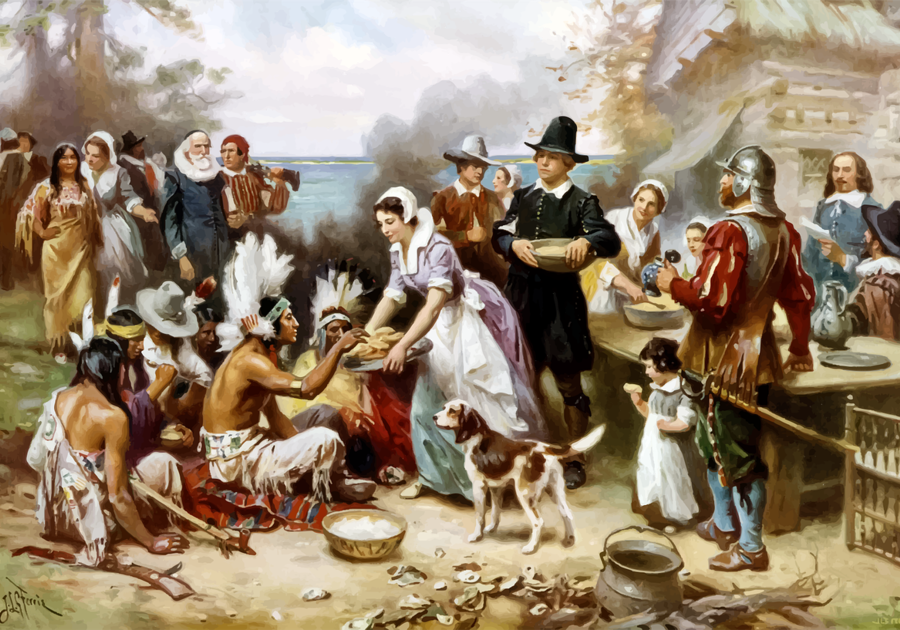Thanksgiving is the day when Americans gather with friends and family for a big feast (at least on a normal year), watch football, and sing along with the Thanksgiving Day parade. It's a day we share, as a family, the things in our lives we are thankful for.
We were taught in school — at least when I was a kid — that the first Thanksgiving was a coming together of the Pilgrims and Native Americans in celebration of a harvest. But were things really that simple? Or have the details faded into the background over time?
Here are five things you may not have known about the history of The First American Thanksgiving.
1. Turkey might not even have been served at the first American Thanksgiving
Pilgrim Edward Winslow wrote about the first Thanksgiving and his account is one of the only primary sources that we have of this event. He wrote that the settlers sent out four men who hunted fowl and brought back enough for a whole week. He also mentioned that wild turkeys were abundant but does not specify that they were served at the feast. It could have just as easily been birds like duck and geese served that day. He does note the Native American Wampanoag tribe brought five deer to add to the meal. Those are the only foods explicitly mentioned by Winslow.
Sadly, likely no pie was served at the first Thanksgiving either, as the Pilgrims did not have much sugar or other components needed to make a pie. Sweet potatoes were also not at the feast, as there were no sweet potatoes in America at that time.
2. The Pilgrims didn’t actually invite the Native Americans to the feast
While Native Americans did end up attending the feast, it is not quite certain how that actually happened. The English written history does not actually point to an invitation, while the Native American oral history does not go back as far as this event. Winslow wrote that 90 Native American men, including their leader Massasoit, feasted among the Pilgrims for three days. It's thought that the Pilgrims, firing off their guns and cannons in celebration of their harvest, gained the attention of the nearby Wampanoags, who came to investigate, the historic preservation officer of the Mashpee Wampanoag Tribe says. This could be how these two cultures came together for this famous feast.
Regardless, this was a remarkable cross-cultural event because over the course of history Native Americans and the colonists had far from a peaceful relationship.
3. Squanto learned English because he was enslaved in Europe and returned to Massachusetts, and still helped the Pilgrims
Squanto was a Native American who was part of the Patuxet, a group of the Wampanoag tribe. He was an incredible help to the settlers. He even crossed the Atlantic Ocean after being kidnapped and sold as slave labor. During his travels he learned English. When he arrived back at his home in 1619, he found his tribe had perished. He was the last of the Patuxet.
Two years later he helped the Pilgrims by acting as a translator between them and the Wampanoag tribe. He also taught the Pilgrims how to grow crops in their new home, as the soil acidity was very different than what they were used to.
4. Only four women settlers were at the first Thanksgiving feast
Pilgrim men believed women had a "weaker body" and that the voyage across the ocean would be too much to bear. So many Pilgrims left their wives and families behind in hopes that they would join them later, once things were more settled.
But 18 husbands decided to bring their wives along with them, and all 18 women survived the voyage. But it turned out the voyage was the easy part. Of the original 18 women who arrived on the Mayflower in November 1620, only 5 women survived to the spring of 1621. By the time of the famous harvest feast, there were only four women remaining, which is just one way the photo above isn't an accurate rendering of the occasion.
5. Thanksgiving did not become a national Holiday until 1863
In 1863, Abraham Lincoln proclaimed Thanksgiving as a national holiday to celebrate and show gratitude for a win in a Gettysburg battle during the American Civil War. This was a culmination of a 36-year campaign made by Sarah Josepha Hale, the original author of the nursery rhyme "Mary Had a Little Lamb." Her persuasive writings on why Thanksgiving should be a national holiday are believed to be the main reason Lincoln decided to make a national day of Thanksgiving.
Want to know more? Have some fun learning about the history of Thanksgiving with your kids with these online tools:
- Become a history detective and discover what happened at the First Thanksgiving
- Games that might have been played at the first Thanksgiving that your family can play now
Helen Partlow is the publisher of Macaroni Kid Mt. Sinai and Port Jefferson, N.Y.



